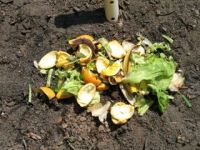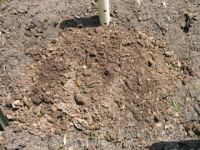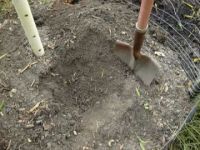Composting experts say to keep putting vegetable scraps in the bin for a few days. Then, when the peels extend over the whole bin to a depth of 4 to six inches, to cover it all with a layer of dirt.
I soon found that results in hordes of fruit flies.
My
method is to put the scraps into the bin (as in the photo at left), chop
them up with the sharpened shovel blade, then
immediately cover them with earth (as in the photo at right). Not a
lot of earth, just enough to cover the
veggies.

"Sharpened shovel blade" needs emphasis. A few seconds with a file sharpens the front of the shovel to where it lets larger pieces become smaller ones. Makes a big difference.
Covering the scraps right away looks better and, more important, keeps flies and odor at bay.
Now where will we get the earth to cover those veggies? Eventually Ė in only one summer - weíll have plenty of our own, created by our composting, but until then, we have to use bags of topsoil or composted manure from the big-box stores.
We just stack the bags of dirt near our compost bins. I keep an old broken knife out there to cut open the plastic bags.
Some experts say to always ensure our bins have a natural depression in the middle to catch rain water. Am not saying that's wrong, but the natural tendency is for the bin to be higher in the center, and it's hard to win that fight. I just throw the new veggies wherever's lowest.
Keeping our compost
moist is important when it's not raining. K
Something
to try is a 4-ft length of 2Ē PVC pipe (in the plumbing section).
 Drill
large holes throughout the length of the pipe. With a hacksaw, cut one end of
the pipe at a
sharp angle to make it easier to pound into the ground. Pound the pipe down the middle of
the bin when the pile is starting to be formed. The opening at the top of
the pipe lets some rain and a lot of oxygen down into the center of the pile.
Drill
large holes throughout the length of the pipe. With a hacksaw, cut one end of
the pipe at a
sharp angle to make it easier to pound into the ground. Pound the pipe down the middle of
the bin when the pile is starting to be formed. The opening at the top of
the pipe lets some rain and a lot of oxygen down into the center of the pile.
At
least thatís the theory. I donít know if it really works, but I usually use it.
When I donít, the compost turns out pretty well anyway.
Some experts say to add ordinary 10-10-10 fertilizer to the bin to help the bacterial action, but this is something else I never do. Likewise, the compost additives we see at the stores are also optional, and I've never used them.
If we put leaves in our compost bin, they should - maybe must - be shredded first. Otherwise they take forever to decompose. (Don't ask me how I know this.)
We might also want to put red wriggler worms in our bins. I would except that my dear wife is phobic about worms, so I don't. But it's something to consider.
Now this is important: we don't want to put into our bins anything not in the vegetable or fruit families. No meat, no bones, no dairy products, no cooking oils. I've put in ashes from the barbecue, but that was for the lime, and that was stretching it. Compost bins are for plants and veggies only.
next: Why two bins